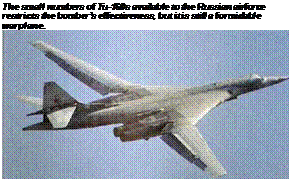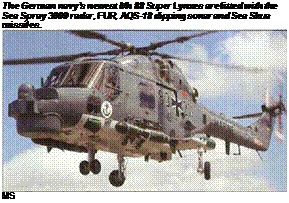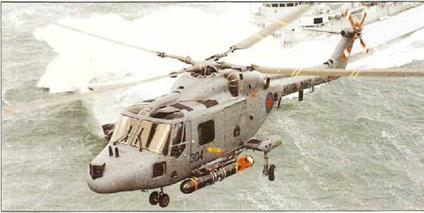Tupolev Tu-160 ‘Blackjack’
|
|
T |
he Tu-160 ‘Blackjack’ is the world’s largest bomber, and is the heaviest combat aircraft ever built. The Tu-160 was heavily influenced by the Rockwell B-1A, designed to penetrate at high leve, relying on performance and a highly sophisticated ECM suite to get through hostile defences. The B-1A was cancelled, and then subsequently resurrected as the B-1B, relying on low-level subsonic flight and reduced RCS to penetrate. The Tu-160 remains committed to both low – evel transonic penetration and high-level supersonic penetration, however. The aircraft is a dedicated cruise missile carrier, with two tandem fuselage weapons bays each containing a rotary carousel for six RK-55 (AS-15 ‘Kent’) cruise missiles (with 200-kT warhead and a range in excess of 3000 km), 12 Kh-15P (AS-16 ‘Kickback’) ‘SRAMskis’ or free-fall bombs The Tu-160’s variable-geometry wing and full- span leading-edge slats and trailing-edge double – slotted flaps confer a useful combination of benign low-speed handling and high supersonic speed, Its cockpit is eouipped with fighter-type control columns and conventional_analog instrument displays, with no MFDs, CRTs and no HUD. The long pointed radome houses a TFR, with a fairing below for *he forwarc-looking TV camera used for visual weapon aiming. A retractable IFR probe endows intercont nertal range.
The development programme of the Tu-160 was extremely protracted. Following a first flight on 19
December 1981, series production eventually began at Kazan in 1986 and continued until termination in January 1992, One incomplete aircraft was later finished ano delivered in 2000. Even after the aircraft entered service, problems continued to severely restrict operations. These included a shortage of basic flying equipment, problems with the aircraft’s K-36A ejection seats and poor reliability of engines and systems.
Between 32 and 39 Tu-160s have been built, including prototypes, about four of which are now derelict at ZhukhovskC Nineteen Tu-160s were delivered to the 184th Heavy Bomber Regiment at Priluki from ‘987. These were left under Ukrainian command after the break-up oJ the USSR, but eight were later transferred back to Russian control and the remainder were scrapped (or, in the case of three aircraft, demilitarised as commercial satellite launch p atforms). Six newer aircraft wen* to Engels, which had been intended to be the first Tu-160 base, where they ware joined by the eight ex-Ukrainian aircraft in 2001.
 Specification: Tupolev Tu-160 ‘Blackjack-A’ Powerplant: four 245.16-kN (55,115-lb) SSEE Trud (Kuznetsov) NK-321 turbojets Dimensions: wig span 55.7G m |i B2 ft 9 in) spreac and 35.60 rh Г16 ft 9.75 in) swept; length 5410 nri (177 ft 6 in); height 13.10 n (43 ft 0 in)
Specification: Tupolev Tu-160 ‘Blackjack-A’ Powerplant: four 245.16-kN (55,115-lb) SSEE Trud (Kuznetsov) NK-321 turbojets Dimensions: wig span 55.7G m |i B2 ft 9 in) spreac and 35.60 rh Г16 ft 9.75 in) swept; length 5410 nri (177 ft 6 in); height 13.10 n (43 ft 0 in)
Weights: empty equipped 110D03 kg (260,140 lb); maximum take-off 276000 kg [506.261 lb!
Performance: maximum level speed ‘clean’ at 11030 m 136,030 ft) 2000 kmh (1,243 mpb); range 14000 km (8,699 miles]
Armament: maximum ordnance ;oad about 15330 kq (36,000 в) in two tandem fuselage weapons bays.
 Anti-tank, battlefield utility, naval ASW and ASuV helicopter
Anti-tank, battlefield utility, naval ASW and ASuV helicopter
|
|
L |
aunched under (he Anglo-French helicopter agreement of Feoruary 1967, the Westland Lynx is an extremely versatile and agile nelicopter with cigital flight controls and a four-bladed semi-rigid main rotor. The first prototype flew on 21 March 1971. The production Lynx HAS. Mk 2 undertook a range of shipboa-d missions including ASW, SAR. ASV search and strike, reconnaissance, troop transport, and VertRep duties. The HAS. Mk 3 introduced Gem 41-1 turboshafts, and subsequent upgrades included the HAS. Mk 3S with secure speech facility, the HAS. Mk 3ICE tor use aboard the Antarctic survey vessel Endurance, the HAS. Mk 3CTS with a new central tactical system and the HAS. Mk 3GM with improved cooling, IR jammers and ALQ-167 ECM pods. Foreign customers for the first-generation naval Lynx were Argentina, Brazil, Denmark, France, Germany, the Netherlands, Nigeria and Norway,
The second-generation Lynx introduced new composite rotor blades with swept ‘BERP’ highspeed tips, which were fitted to new-bulld Super Ly nxes delivered to Brazil, South Korea and Portugal. These aircraft also had a new 360° undernose radar and some had provision for a nose – mounted FLIR. The new rotor was also a feature of
the Royal Navy Lynx HAS. Mk 8, produced by conversion of surviving HAS. Mk 3s. This variant also introduced an undernose radome, a nose- mounted thermal imager turret, a rear-mounted MAD, Orange Crop ESM and a Yellow Veil ECM jamming pod.
The Army Lynx had a skid undercarriage, and was ordered by the UK Army Air Corps as the Lynx AH. Mk 1. The only export customer was the Qatar Police. Able to carry 12 troops or 907 kg (2,000 lb) of internal freight, most AAC Lynxes were modified with roof-mounted sights and provision for eight TOW anti-tank missiles, Most were subsequently converted to Lynx AH. Mk 7 standards (also produced in smell numbers as a new-build aircraft), with a reverse-direction tail rotor, uprated Gem 41 engines and a box-like IR exhaust shroud. The Lynx AH. Mk Э (offered for export as the Battlefield Lynx) incorporated all the AH. Mk 7 modifications and also introduced a new nosewheel undercarriage The first new-build example flew on 20 July 1990.
Westland is now offering a Super Lynx 200 configuration, with LHTEC CTS800-4N turboshafts, and a Super Lynx 300 with T8QQ engines, an EFlS cockpit, and advanced avionics. The latter version was ordered by Malaysia and South Africa.
 Specification: Westland Lynx AH. Mk 7 Powerplant two846-kW|t,135Tip) Rolls – Royce Gem 42-1 turboshgf-s Dimensions: main rotor diameter 12.80 m •|42 (t|; length overall, rotors turning ’19 ft 9 in (15.16 m); height overall 12 ft (3.73 m) with rotors stationary
Specification: Westland Lynx AH. Mk 7 Powerplant two846-kW|t,135Tip) Rolls – Royce Gem 42-1 turboshgf-s Dimensions: main rotor diameter 12.80 m •|42 (t|; length overall, rotors turning ’19 ft 9 in (15.16 m); height overall 12 ft (3.73 m) with rotors stationary
Weights: operating empty 3072 kg 16,77/ lb| in the anti-tank role: maximum take-oil 4876 kg) ■110,75C lb); maximum payload 3.30U lb (1365 kg) Performance: maximum contnucibs cruising speed 256 kmh (159 mph); maximum rate of climb at sea level 756 m (2,480 ft) per minute; hovering ceiling 3230 m (10,600 ft); combat radius 46 km (29 miles) lor a 2-hour patrol Armament: 550 kg (1,210 lb) of ordnance













